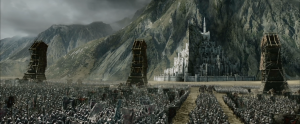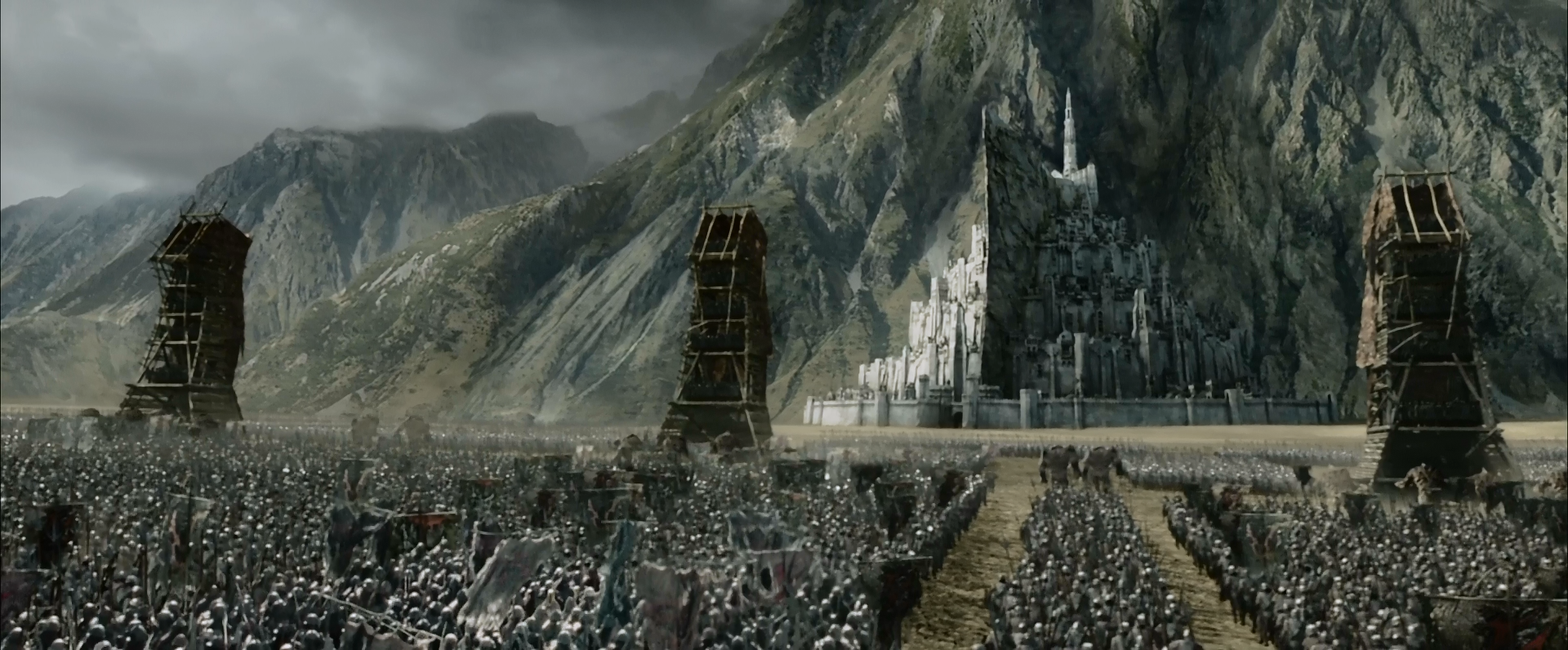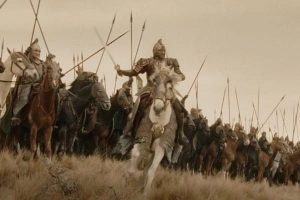by Bryan & Francis
Hobbit Day has come again, and with it, Bryan and Francis’ now-traditional post discussing some element of intersection between history and that beloved fantasy realm of Middle Earth. This week, in what may become a long-running series here at Concerning History, Bryan and Francis dissect the climactic siege of Minas Tirith and Battle of the Pelennor Fields from The Return of the King, showcasing multiple elements of historical inspiration, or at least historical echoes, for the biggest battle described in detail Tolkien’s legendarium. Please forgive the longer-than-usual post; they’re both incurable nerds…

The Siege of Minas Tirith: The siege of Minas Tirith is first and foremost, well, a siege. Sauron’s forces, comprised of the Hosts of Minas Morgul, Near Harad, and Rhun, enclose the White City with over one hundred thousand orcs, trolls, and evil men. It’s outer defenses breached and it’s outlying territories pinned down by the marauding Corsairs of Umbar, the capital of Gondor must rely on its seven-tiered construction, massive main gate, and steely resolve to last the night. Siege warfare was pioneered in the ancient world by the Hellenistic Greeks, with Alexander the Great and his successors constructing massive siege towers and even, in one memorable instance, connecting the island of Tyre to the mainland with an earthen causeway that exists to this day. The Romans elevated sieges through their engineers’ construction of field fortifications and artillery which persisted into the Middle Ages and the high point of sieges. Even as late as the eighteenth century, European armies were waging war much the same way, although now using black powder ordnance and trying to break into star forts. At Minas Tirith, under the deep night of Sauron’s Dawnless day, orcish catapults and Gondorian trebuchets exchange fire while siege towers are pushed against the walls and the massive battering ram Grond attempts to force the city’s gates. Psychological warfare is employed as severed Gondorian heads are flung over the walls in the style of Chinggis Khan. But for the magic and fantastical creatures, a Roman legionary, medieval knight, or British grenadier would be right at home in assault or defence of Minas Tirith.
Arise, Riders of Theoden! The Charge of the Rohirrim: The siege of Minas Tirith ends and the Battle of the Pelennor Fields begins with the arrival of Theoden King and the forces of Rohan from the north. A massive cavalry charge cuts deep into the forces of Mordor, relieving the just-breached gate and bringing with it the first rays of dawn to end the Dawnless Day. While Tolkien may have based the culture of Rohan on his beloved Anglo-Saxons (see last year’s post on that very subject), here the Riders of Rohan enter a different era: the High Middle Ages, where cavalry (particularly heavy cavalry) dominated the battlefield. Knights formed the backbone of any medieval European army, and the charge’s role in breaking an enemy in battle would hold central place until well into the modern period (with ever-decreasing effectiveness). Note, though, that a cavalry charge is much more deft a maneuver than simply riding straight at the enemy. A horse, no matter how well trained, will never charge a seemingly-solid object, and so is little use against a packed, disciplined formation of infantry. Instead, charges must either challenge the nerve of infantry, causing them to break formation, or strike the less-organized flanks or rear. Here, Theoden and his riders take the Enemy in the flank and carry all before them in a charge that may just end up being too successful…
 The Death of Kings: Swooping from the sky, the shadow of the Witch-King of Angmar’s fell-beast alarms Snowmane, King Theoden of Rohan’s mighty steed. Rider and mount fall to the earth, Theoden’s guard scatter, and the Lord of the Nazgul descends to finish the kill. Theoden, his body broken, lies dying upon the field. However, in the midst of chaos, a lone warrior faces the Witch-King. This warrior slays the Witch-King’s steed and duels with the Lord of the Nazgul. At the last moment, a small warrior, Meriadoc Brandybuck of the Shire, stabs the Witch-King in the leg and his main opponent reveals herself as Eowyn, Theoden’s niece and a shield-maiden of Rohan. Fulfilling an old prophecy which said the Witch-King could be slain “by no man,” she slays the Witch-King and destroys Sauron’s mightiest captain. In shock and grief, Eomer, Theoden’s heir and nephew, sees his sister and uncle dead upon the battlefield and charges into the hosts of Mordor, intent upon revenge.
The Death of Kings: Swooping from the sky, the shadow of the Witch-King of Angmar’s fell-beast alarms Snowmane, King Theoden of Rohan’s mighty steed. Rider and mount fall to the earth, Theoden’s guard scatter, and the Lord of the Nazgul descends to finish the kill. Theoden, his body broken, lies dying upon the field. However, in the midst of chaos, a lone warrior faces the Witch-King. This warrior slays the Witch-King’s steed and duels with the Lord of the Nazgul. At the last moment, a small warrior, Meriadoc Brandybuck of the Shire, stabs the Witch-King in the leg and his main opponent reveals herself as Eowyn, Theoden’s niece and a shield-maiden of Rohan. Fulfilling an old prophecy which said the Witch-King could be slain “by no man,” she slays the Witch-King and destroys Sauron’s mightiest captain. In shock and grief, Eomer, Theoden’s heir and nephew, sees his sister and uncle dead upon the battlefield and charges into the hosts of Mordor, intent upon revenge.
This part of the Battle of Pelennor Fields is one of the most Medieval in Tolkien’s tale. Why is that? Well, it highlights just how integral kings were to the command structure and integrity of armies on the Medieval battlefield. Medieval states were often the traveling apparatus of a king’s court represented by the monarch and his retinue. That meant that the death of a monarch meant the death of the state and the apparatus of government, most often reflected by the military and retinue accompanying a king in his realm or the field of battle. The Battle of Hastings in AD 1066 serves as a good example of this reality. When Harold Godwinson was killed among his Anglo-Saxon troops, the Norman cavalry under William the Conqueror effectively destroyed Godwinson’s Anglo-Saxon state and secured England under a new Norman monarchy.
At the Battle of Pelennor Fields, Theoden’s death leads to a similar disintegration of his forces as they scatter with the Witch-King’s approach. However, Theoden is avenged by a member of his retinue, Eowyn (even though Theoden didn’t know she was present before the battle) and then the “state” of Rohan passes in power to Eomer, who had enough luck to be elsewhere when the Witch-King came to deliver his crippling blow to the Rohirrim.
On the other hand, the Witch-King’s death is a more serious blow to Sauron’s forces. As the incarnation of Sauron’s will and power at Pelennor, the Witch-King instilled considerable fear into his own forces and compelled the legions of Mordor to fight. Lacking that, the hosts of Mordor were thrown into disarray, especially since Theoden had also previously slain the Haradrim commander on the battlefield, too. While Gothmog, the Witch-King’s lieutenant, takes command, the loss of such a pinnacle commander is irrecoverable for the forces of Mordor, especially since new leadership and inspiration is about to arrive for the forces of Gondor and her allies…
The Return of the King: Gothmog’s first command brought Mordor’s reinforcements to the battlefield. Awaiting in Osgiliath, the ruined city bordering Minas Tirith, the armies of Far Harad enter the battle to overwhelm Eomer and prevent the rout of Sauron’s forces. While Eomer’s foolhardy and chivalrous charge put the Rohirrim in a vulnerable position, Gothmog committed his forces completely to the fight and did not have the cohesion necessary to counteract a new threat: the arrival of Aragorn and the forces of the Fiefdoms at Harlond. Coupled with Prince Imrahil of Dol Amroth’s sortie from the gates of Minas Tirith itself, the three Captains of Men slowly overwhelm the hosts of Mordor and leave no enemy alive inside the Rammas Echor at the end of the battle.
battlefield. Awaiting in Osgiliath, the ruined city bordering Minas Tirith, the armies of Far Harad enter the battle to overwhelm Eomer and prevent the rout of Sauron’s forces. While Eomer’s foolhardy and chivalrous charge put the Rohirrim in a vulnerable position, Gothmog committed his forces completely to the fight and did not have the cohesion necessary to counteract a new threat: the arrival of Aragorn and the forces of the Fiefdoms at Harlond. Coupled with Prince Imrahil of Dol Amroth’s sortie from the gates of Minas Tirith itself, the three Captains of Men slowly overwhelm the hosts of Mordor and leave no enemy alive inside the Rammas Echor at the end of the battle.
The key to Aragorn, Imrahil, and Eomer’s combined victory at Pelennor was the timely arrival of reinforcements on the battlefield. In any type of warfare, reinforcements are crucial. Overcommitting reserves or reinforcements too early can lead an army to overextension and defeat in detail. Historic examples in warfare of this phenomenon abound, but, in particular, the Siege of Vienna in 1683 is a pinnacle example of the way reinforcements are crucial to relieving sieges and determining the final outcomes of battles. In 1683, John III Sobieski, the King of Poland, arrived at the city of Vienna in time to beat back a massive Ottoman army that had come to conquer this Habsburg city. This victory, which was brought about by an alliance between Poland, the Holy Roman Empire, and Austria, curbed Ottoman imperial expansion in the Balkans in the 1600s. In many ways, the Siege of Vienna can even be seen as a historical corollary to the Battle of Pelennor Fields since a mighty, expansionist power (Ottoman Empire/Mordor) was stopped by the combined alliances of smaller kingdoms (Poland, Austria, and the HRE/Fiefdoms, Minas Tirith, and Rohan) all threatened by the hegemon’s expansionism (This does not mean the Ottoman Empire is Mordor. Tolkien never used his work as allegory and finding corollaries is not the same as equating an Early Modern imperial state with the evil quasi-theocratic despotism of Mordor).
So there it is! The Battle of Pelennor Fields as a piece of military “history.” The beauty of mythic and epic fantasy is the many inspirations that author’s use to inform the events of their world’s story or history. Tolkien was no stranger to this process (and, is, in fact, the best at it of all epic fantasy writers). The Battle of Pelennor Fields combines so many elements of Medieval and Early Modern warfare that it is both distinct in its epic heroism and poignancy, but also familiar to the eye of the historian. Be on the watch for more analyses of the battles in our favorite epic fantasy and science fiction stories from a historical perspective.

